oil pressure Alfa Romeo MiTo 2015 Owner's Manual
[x] Cancel search | Manufacturer: ALFA ROMEO, Model Year: 2015, Model line: MiTo, Model: Alfa Romeo MiTo 2015Pages: 280, PDF Size: 8.52 MB
Page 12 of 280
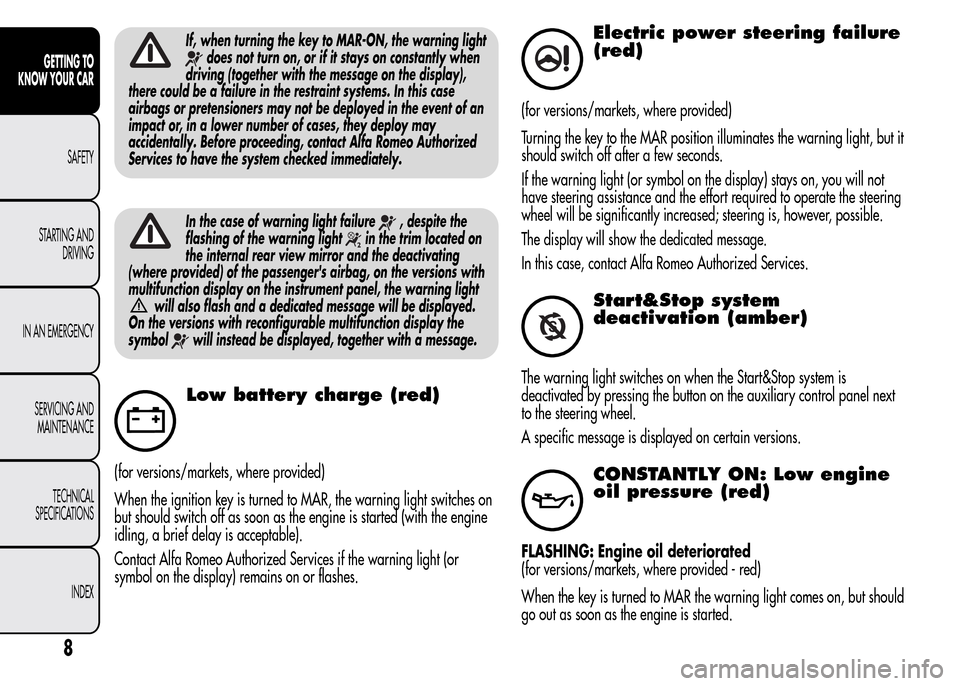
If, when turning the key to MAR-ON, the warning light
does not turn on, or if it stays on constantly when
driving (together with the message on the display),
there could be a failure in the restraint systems. In this case
airbags or pretensioners may not be deployed in the event of an
impact or, in a lower number of cases, they deploy may
accidentally. Before proceeding, contact Alfa Romeo Authorized
Services to have the system checked immediately.
In the case of warning light failure, despite the
flashing of the warning light
in the trim located on
the internal rear view mirror and the deactivating
(where provided) of the passenger's airbag, on the versions with
multifunction display on the instrument panel, the warning light
will also flash and a dedicated message will be displayed.
On the versions with reconfigurable multifunction display the
symbol
will instead be displayed, together with a message.
Low battery charge (red)
(for versions/markets, where provided)
When the ignition key is turned to MAR, the warning light switches on
but should switch off as soon as the engine is started (with the engine
idling, a brief delay is acceptable).
Contact Alfa Romeo Authorized Services if the warning light (or
symbol on the display) remains on or flashes.
Electric power steering failure
(red)
(for versions/markets, where provided)
Turning the key to the MAR position illuminates the warning light, but it
should switch off after a few seconds.
If the warning light (or symbol on the display) stays on, you will not
have steering assistance and the effort required to operate the steering
wheel will be significantly increased; steering is, however, possible.
The display will show the dedicated message.
In this case, contact Alfa Romeo Authorized Services.
Start&Stop system
deactivation (amber)
The warning light switches on when the Start&Stop system is
deactivated by pressing the button on the auxiliary control panel next
to the steering wheel.
A specific message is displayed on certain versions.
CONSTANTLY ON: Low engine
oil pressure (red)
FLASHING: Engine oil deteriorated
(for versions/markets, where provided - red)
When the key is turned to MAR the warning light comes on, but should
go out as soon as the engine is started.
8
GETTING TO
KNOW YOUR CAR
SAFETY
STARTING AND
DRIVING
IN AN EMERGENCY
SERVICING AND
MAINTENANCE
TECHNICAL
SPECIFICATIONS
INDEX
Page 13 of 280
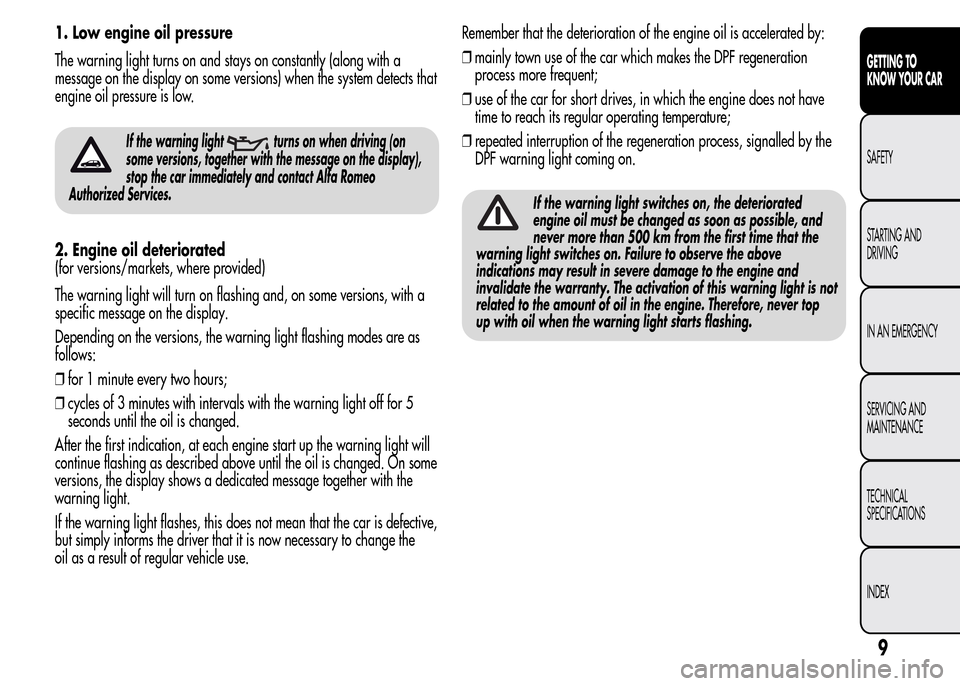
1. Low engine oil pressure
The warning light turns on and stays on constantly (along with a
message on the display on some versions) when the system detects that
engine oil pressure is low.
If the warning lightturns on when driving (on
some versions, together with the message on the display),
stop the car immediately and contact Alfa Romeo
Authorized Services.
2. Engine oil deteriorated
(for versions/markets, where provided)
The warning light will turn on flashing and, on some versions, with a
specific message on the display.
Depending on the versions, the warning light flashing modes are as
follows:
❒for 1 minute every two hours;
❒cycles of 3 minutes with intervals with the warning light off for 5
seconds until the oil is changed.
After the first indication, at each engine start up the warning light will
continue flashing as described above until the oil is changed. On some
versions, the display shows a dedicated message together with the
warning light.
If the warning light flashes, this does not mean that the car is defective,
but simply informs the driver that it is now necessary to change the
oil as a result of regular vehicle use.Remember that the deterioration of the engine oil is accelerated by:
❒mainly town use of the car which makes the DPF regeneration
process more frequent;
❒use of the car for short drives, in which the engine does not have
time to reach its regular operating temperature;
❒repeated interruption of the regeneration process, signalled by the
DPF warning light coming on.
If the warning light switches on, the deteriorated
engine oil must be changed as soon as possible, and
never more than 500 km from the first time that the
warning light switches on. Failure to observe the above
indications may result in severe damage to the engine and
invalidate the warranty. The activation of this warning light is not
related to the amount of oil in the engine. Therefore, never top
up with oil when the warning light starts flashing.
9
GETTING TO
KNOW YOUR CAR
SAFETY
STARTING AND
DRIVING
IN AN EMERGENCY
SERVICING AND
MAINTENANCE
TECHNICAL
SPECIFICATIONS
INDEX
Page 18 of 280
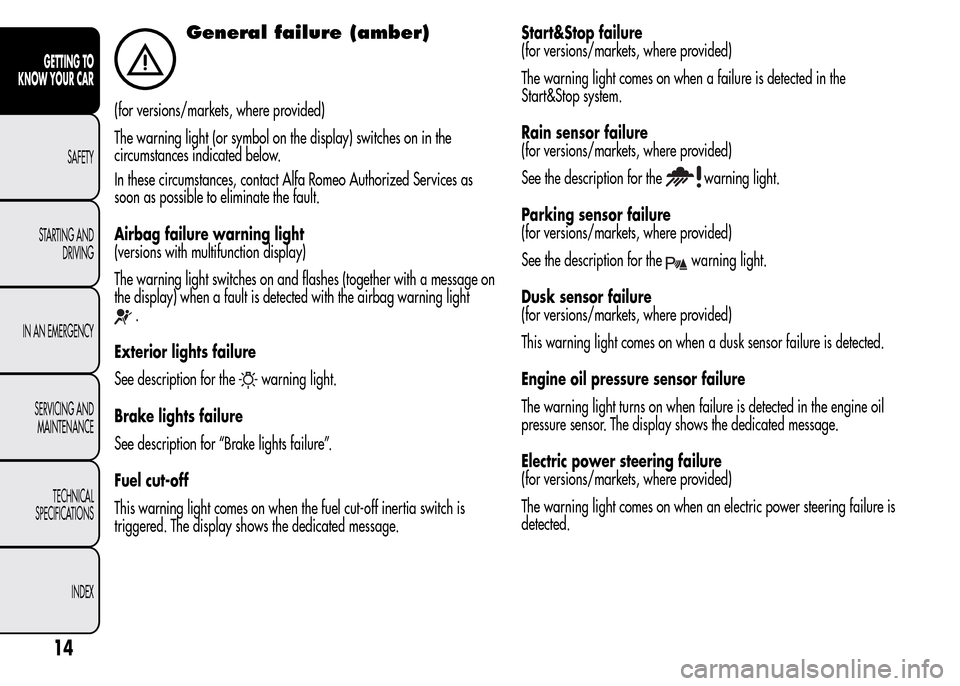
General failure (amber)
(for versions/markets, where provided)
The warning light (or symbol on the display) switches on in the
circumstances indicated below.
In these circumstances, contact Alfa Romeo Authorized Services as
soon as possible to eliminate the fault.
Airbag failure warning light
(versions with multifunction display)
The warning light switches on and flashes (together with a message on
the display) when a fault is detected with the airbag warning light
.
Exterior lights failure
See description for the
warning light.
Brake lights failure
See description for “Brake lights failure”.
Fuel cut-off
This warning light comes on when the fuel cut-off inertia switch is
triggered. The display shows the dedicated message.Start&Stop failure
(for versions/markets, where provided)
The warning light comes on when a failure is detected in the
Start&Stop system.
Rain sensor failure
(for versions/markets, where provided)
See the description for the
warning light.
Parking sensor failure
(for versions/markets, where provided)
See the description for the
warning light.
Dusk sensor failure
(for versions/markets, where provided)
This warning light comes on when a dusk sensor failure is detected.
Engine oil pressure sensor failure
The warning light turns on when failure is detected in the engine oil
pressure sensor. The display shows the dedicated message.
Electric power steering failure
(for versions/markets, where provided)
The warning light comes on when an electric power steering failure is
detected.
14
GETTING TO
KNOW YOUR CAR
SAFETY
STARTING AND
DRIVING
IN AN EMERGENCY
SERVICING AND
MAINTENANCE
TECHNICAL
SPECIFICATIONS
INDEX
Page 176 of 280

SCHEDULED SERVICING PLAN
PETROL VERSIONS
Thousands of miles 9 18 27 36 45 54 63 72 81 90
Thousands of kilometres 15 30 45 60 75 90 105 120 135 150
Years12345678910
Check tyre condition/wear and adjust pressure, if necessary. Check
“Fix&Go Automatic” kit recharge expiry date●●●●●●●●●●
Check operation of lighting system (headlights, direction indicators,
hazard warning lights, luggage compartment, passenger
compartment, glove compartment, instrument panel warning lights,
etc.)●●●●●●●●●●
Check and, if necessary, top up fluid levels (engine coolant, hydraulic
clutch/brakes, screen washer, battery, etc.)●●●●●●●●●●
Check exhaust emissions/smokiness●●●●●●●●●●
Use the diagnosis socket to check supply/engine management system
operation, emissions and, for versions/markets, where provided,
engine oil degradation●●●●●●●●●●
Visually inspect condition of: exterior bodywork, underbody
protection, pipes and hoses (exhaust, fuel system, brakes), rubber
elements (boots, sleeves, bushes, etc.)●●●●●
Check windscreen/rear window wiper blade position/wear●●●●●
Check operation of windscreen wiper/washer system and adjust jets,
if necessary●●●●●
Check cleanliness of bonnet and luggage compartment locks, as well
as cleanliness and lubrication of linkages●●●●●
172
GETTING TO KNOW
YOUR CAR
SAFETY
STARTING AND
DRIVING
IN AN EMERGENCY
SERVICING AND
MAINTENANCE
TECHNICAL
SPECIFICATIONS
INDEX
The checks listed in the Scheduled Servicing Plan, after reaching 120,000 km/8 years, must be cyclically repeated starting from the first interval,
thus following the same intervals as before.
Page 179 of 280
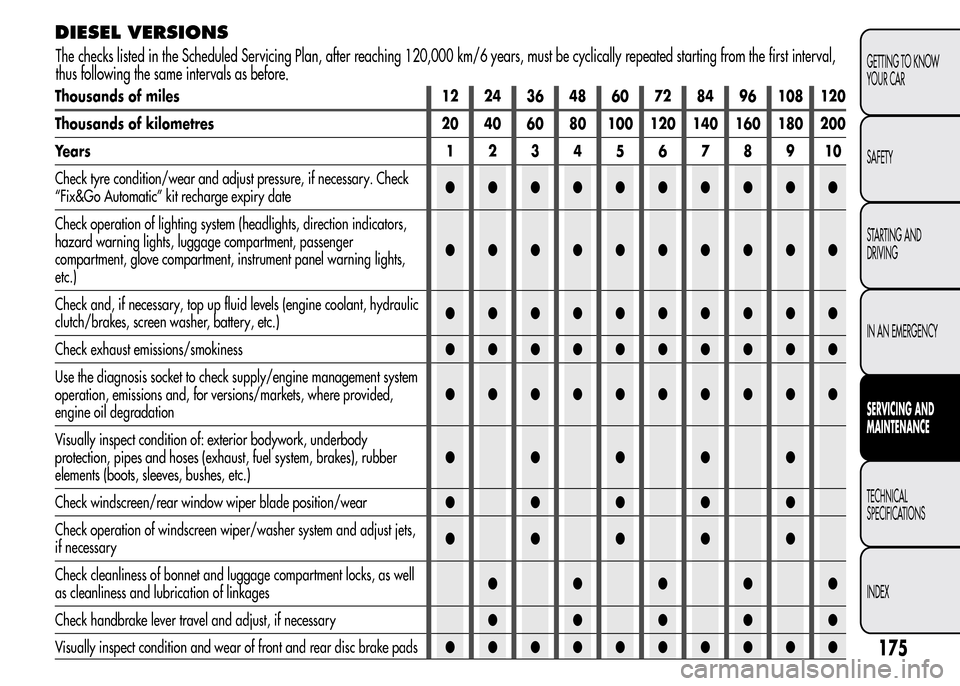
DIESEL VERSIONS
Thousands of miles 12 24 36 48 60 72 84 96 108 120
Thousands of kilometres 20 40 60 80 100 120 140 160 180 200
Years12345678910
Check tyre condition/wear and adjust pressure, if necessary. Check
“Fix&Go Automatic” kit recharge expiry date●●●●●●●●●●
Check operation of lighting system (headlights, direction indicators,
hazard warning lights, luggage compartment, passenger
compartment, glove compartment, instrument panel warning lights,
etc.)●●●●●●●●●●
Check and, if necessary, top up fluid levels (engine coolant, hydraulic
clutch/brakes, screen washer, battery, etc.)●●●●●●●●●●
Check exhaust emissions/smokiness●●●●●●●●●●
Use the diagnosis socket to check supply/engine management system
operation, emissions and, for versions/markets, where provided,
engine oil degradation●●●●●●●●●●
Visually inspect condition of: exterior bodywork, underbody
protection, pipes and hoses (exhaust, fuel system, brakes), rubber
elements (boots, sleeves, bushes, etc.)●●●●●
Check windscreen/rear window wiper blade position/wear●●●●●
Check operation of windscreen wiper/washer system and adjust jets,
if necessary●●●●●
Check cleanliness of bonnet and luggage compartment locks, as well
as cleanliness and lubrication of linkages●●●●●
Check handbrake lever travel and adjust, if necessary●●●●●
Visually inspect condition and wear of front and rear disc brake pads●●●●●●●●●●
175
GETTING TO KNOW
YOUR CAR
SAFETY
STARTING AND
DRIVING
IN AN EMERGENCY
SERVICING AND
MAINTENANCE
TECHNICAL
SPECIFICATIONS
INDEX
The checks listed in the Scheduled Servicing Plan, after reaching 120,000 km/6 years, must be cyclically repeated starting from the first interval,
thus following the same intervals as before.
Page 181 of 280
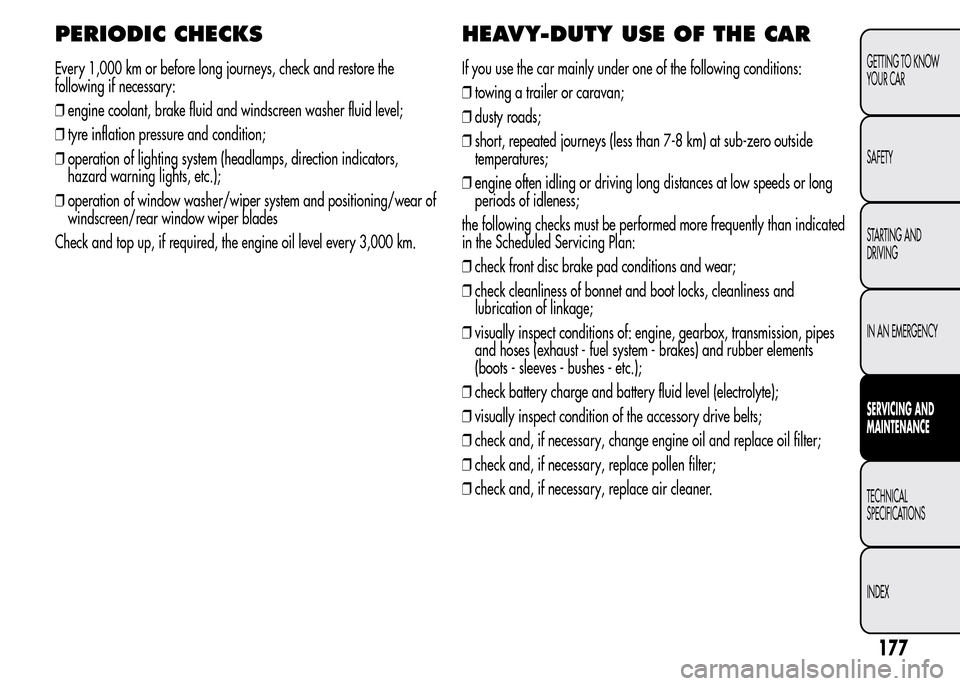
PERIODIC CHECKS
Every 1,000 km or before long journeys, check and restore the
following if necessary:
❒engine coolant, brake fluid and windscreen washer fluid level;
❒tyre inflation pressure and condition;
❒operation of lighting system (headlamps, direction indicators,
hazard warning lights, etc.);
❒operation of window washer/wiper system and positioning/wear of
windscreen/rear window wiper blades
Check and top up, if required, the engine oil level every 3,000 km.
HEAVY-DUTY USE OF THE CAR
If you use the car mainly under one of the following conditions:
❒towing a trailer or caravan;
❒dusty roads;
❒short, repeated journeys (less than 7-8 km) at sub-zero outside
temperatures;
❒engine often idling or driving long distances at low speeds or long
periods of idleness;
the following checks must be performed more frequently than indicated
in the Scheduled Servicing Plan:
❒check front disc brake pad conditions and wear;
❒check cleanliness of bonnet and boot locks, cleanliness and
lubrication of linkage;
❒visually inspect conditions of: engine, gearbox, transmission, pipes
and hoses (exhaust - fuel system - brakes) and rubber elements
(boots - sleeves - bushes - etc.);
❒check battery charge and battery fluid level (electrolyte);
❒visually inspect condition of the accessory drive belts;
❒check and, if necessary, change engine oil and replace oil filter;
❒check and, if necessary, replace pollen filter;
❒check and, if necessary, replace air cleaner.
177
GETTING TO KNOW
YOUR CAR
SAFETY
STARTING AND
DRIVING
IN AN EMERGENCY
SERVICING AND
MAINTENANCE
TECHNICAL
SPECIFICATIONS
INDEX
Page 199 of 280
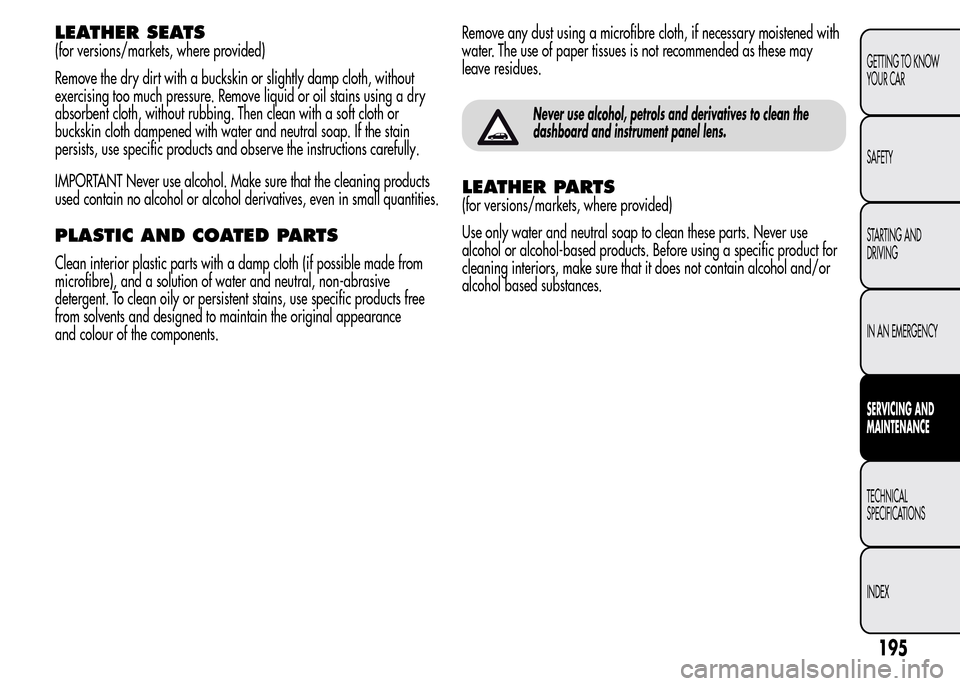
LEATHER SEATS
(for versions/markets, where provided)
Remove the dry dirt with a buckskin or slightly damp cloth, without
exercising too much pressure. Remove liquid or oil stains using a dry
absorbent cloth, without rubbing. Then clean with a soft cloth or
buckskin cloth dampened with water and neutral soap. If the stain
persists, use specific products and observe the instructions carefully.
IMPORTANT Never use alcohol. Make sure that the cleaning products
used contain no alcohol or alcohol derivatives, even in small quantities.
PLASTIC AND COATED PARTS
Clean interior plastic parts with a damp cloth (if possible made from
microfibre), and a solution of water and neutral, non-abrasive
detergent. To clean oily or persistent stains, use specific products free
from solvents and designed to maintain the original appearance
and colour of the components.Remove any dust using a microfibre cloth, if necessary moistened with
water. The use of paper tissues is not recommended as these may
leave residues.
Never use alcohol, petrols and derivatives to clean the
dashboard and instrument panel lens.
LEATHER PARTS
(for versions/markets, where provided)
Use only water and neutral soap to clean these parts. Never use
alcohol or alcohol-based products. Before using a specific product for
cleaning interiors, make sure that it does not contain alcohol and/or
alcohol based substances.
195
GETTING TO KNOW
YOUR CAR
SAFETY
STARTING AND
DRIVING
IN AN EMERGENCY
SERVICING AND
MAINTENANCE
TECHNICAL
SPECIFICATIONS
INDEX